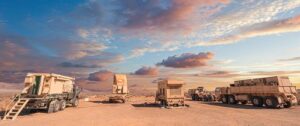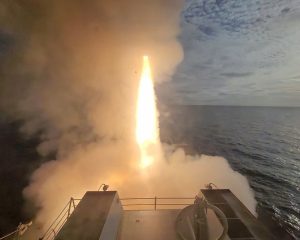The Missile Defense Agency (MDA) is supporting the Air Force in its cruise missile defense program with plans to test a national capital region capability later this summer, the head of the agency said last week.
During the McAleese Defense programs conference, MDA Director Vice Adm. Jon Hill confirmed Deputy Secretary of Defense Kathleen Hicks appointed the Air Force as the lead service for homeland cruise missile defense.

Hill explained the mission is designed to defend against long range supersonic strategic cruise missiles, so the Air Force is making investments in sensors to pick them up so they can then develop a fire control solution.
He said with the Air Force taking the lead, MDA has been asked to continue its work on developing a National Capital Region cruise missile defense demonstration as part of supporting the Air Force.
Hill characterized the demonstration as two hardware-in-the-loop series, where they synchronize existing cruise missile defense systems, “kind of think Army [Integrated Air and Missile Defense Battle Command System, IBCS], think Navy destroyers – and we set that up and we had our first run on that [in February] that went really well. And you learn a lot when you do that sort of event.”
He said the next hardware test event is expected in June followed by a live fire test in August.
All of the data from these tests will be sent to the Air Force “so they can go work the longer-range architectures” and develop sensors.
Hill said he and MDA care about this mission because he needs access to those new cruise missile defense sensors the Air Force will have to procure for other MDA missions.
“We are sensor-poor in every mission that we have. And so if there’s a new set of sensors coming, I want access to those. That’s why we’re fully supporting what the Air Force does, because we need it for our mission,” Hill said.
Hill told reporters during the McAleese conference that Northern Command and NORAD initially went to MDA several years ago when they were first concerned about cruise missile defense as a requirement.
“So we worked out several different architecture options for them, leveraging existing systems because if it was about speed and because it’s an existing threat, we want to move quickly. So we looked at the existing Army air defense capabilities, we looked at Navy air defense capabilities. I said, how do we bring those together in an architecture that would work for NORTHCOM.”

Hill said the testing MDA is now working through continues that initial effort and MDA is working closely with the Air Force as they stand up their programs and figure out how to integrate various capabilities for the cruise missile defense purpose.
He noted while MDA has a clear program mission, the services do not have mission-based program offices like his but those based on specific capabilities like radars, command and control systems.
“So they’ll figure out how they’re going to integrate across those programs to bring that capability forward. So we’re working closely really” at the Air Staff and with their chief scientists, and their Rapid Capabilities Office.
Hill said since the Air Force now owns the cruise missile defense mission they will likely do an analysis of alternatives, which will involve re-looking at the architecture MDA put together for this year’s tests.